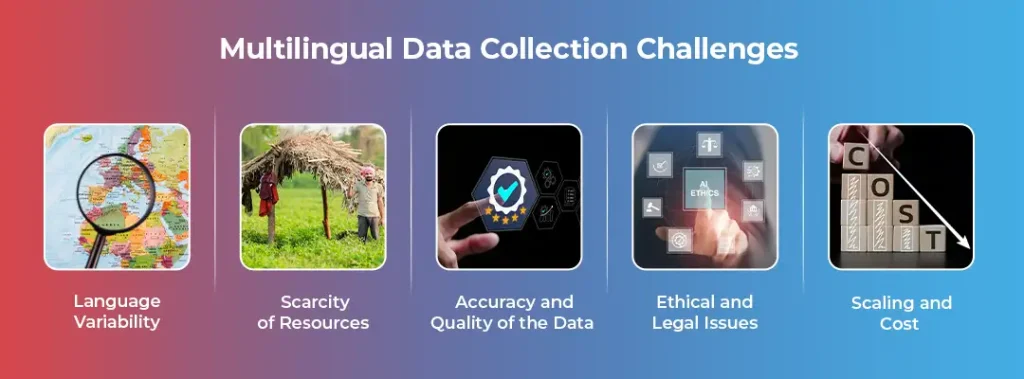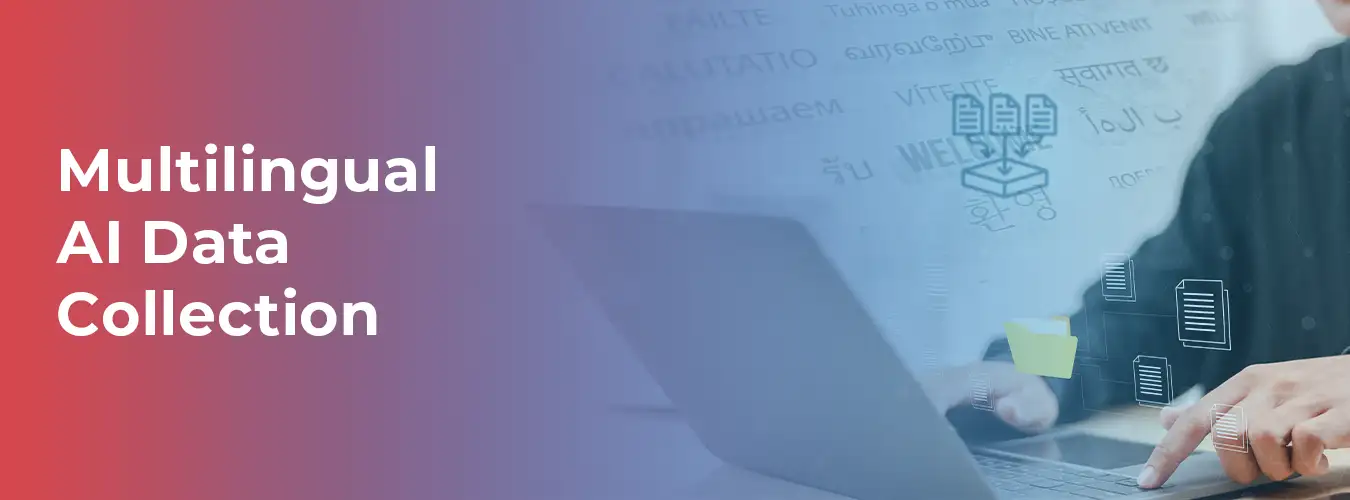- What Does AI Data Collection Entail and Why Are Multilingual Datasets Important?
- Why do these datasets matter?
- Multilingual Data Collection Challenges
- Best Practices for AI Data Collection in Multiple Languages
- Tools and Technologies Enabling Effective Data Collection
- Practical Uses Enabled by AI Datasets in Different Languages
- The Next Steps Towards Innovation with Multilingual AI
- FAQs
Multilingual AI Data Collection: Its Importance for AI Development
The efficiency of Artificial Intelligence (AI) depends entirely on the data it is fed during the learning process. An AI constructs its model through a comprehensive training phase that involves a tremendous amount of data depicting real-life situations. The problem arises when we consider that people speak more than 7,000 languages globally, which means that collecting AI data for different languages becomes vital for building effective AI systems.
The implementation of AI systems within natural language processing (NLP) or the development of inclusive AI-powered solutions within education or medicine are only a few examples of what is possible when AI works with multilingual datasets. This allows people from different ethnic and cultural backgrounds to communicate and interact seamlessly. This article covers why collecting multilingual AI data is important and what challenges innovators face in that area.
By the end of this article, we will cover how to collect multilingual datasets and their importance, as well as explain how this sets the foundation for a more powerful neural network.
What Does AI Data Collection Entail and Why Are Multilingual Datasets Important?
Gathering various types of information, such as images, text, or voice recordings to create a distinct machine learning model, is referred to as the AI data collection process. A model requires this information to identify certain traits, make logical conclusions, and engage in activities that simulate human behavior.
The major problem today lies in the fact that English-oriented datasets focus on serving specific populations, therefore leading to whole other regions suffering in access to technology.
Equity AI seeks to operate across multiple languages, and so multilingual datasets are issued to aid in bridging the gap.
For example, creating a voice recognition software for English and Telugu speakers, or a chatbot that speaks French and Mandarin, entails developing specific, high-quality language datasets. Macgence is one of the multinational companies that specializes in creating training data for AI/ML technologies, and is crucial for the creation of these datasets.
Why do these datasets matter?
Cultural Contexts: AI understanding of region-specific and culturally relevant slang, idioms, and phrases is made possible through the multilingual data.
Global Reach: Multilingual models help scale tech products to non-English speaking countries where the residents’ ability to speak English is poor.
Bias Reduction: Multilingual AI creates equitable systems by diversifying the training dataset and therefore depend less on biased models for training.
Multilingual Data Collection Challenges

Even though accurate multilingual datasets need to be collected, it sure is tedious. These are the challenges faced:
1. Language Variability
Languages are often split into varying regions, dialects, and accents. The difference in model performance between Brazilian Portuguese and European Portuguese provides a pivotal example. Sparse Standardized Linguistic Data Collection is necessary.
2. Scarcity of Resources
Smaller languages, such as Hausa, Xhosa, and Quechua, have severely lacking resources while well-known speech languages such as English and Chinese are notorious for having abundant data.
Creating datasets for these languages needs more time and in-depth knowledge of local cultures, traditions, and practices.
3. Accuracy and Quality of the Data
In order for AI to work as intended, the results given in the data must be precise; so the training data must be clean and well-copy annotated. When working with multilingual data, experts fluent in the language are needed as these professionals need to ensure the translations, transcriptions, and annotations are correct.
4. Ethical and Legal Issues
User data that is sensitive taken for training purposes poses the danger of infringing on privacy laws. In dealing with personal text or voice samples, it is important to comply with data protection regulations such as GDPR especially when it comes to using or abusing private information.
5. Scaling and Cost
Finding a good balance on the collection of high-quality data without too much spending money can be a challenge for a lot of organizations. The majority of enterprises turn to data providers like Macgence because they know how to manage this.
Best Practices for AI Data Collection in Multiple Languages
Building exhaustive multilingual datasets needs thorough and careful consideration. These practices are there to ensure things are done effectively:
1. Identify Target Cases and Languages
Decide what languages are important to your AI platform. Are you using data for medical sector chatbots? Focus on the languages within your geo-zone. Are you introducing a new product globally? Prepare data that cover several language groups.
2. Use a Variety of Data Providers
Get local speakers from different regions and dialects. This will guarantee that we accurately represent both the formal and informal aspects of the language.
3. Guarantee Quality Assurance
Establish procedures to conduct checks of language-specific annotations and translations for precision. Employ linguists and domain specialists to audit the data.
4. Legal and Ethical Practices
Follow user privacy regulations when handling data. Always make sure to obtain consent and anonymize any delicate data.
5. Rely on Outside Experts
Working with a cross-language data provider such as Macgence allows companies to obtain expertly annotated datasets without straining internal resources.
6. Implement Continuous Training
Don’t stop at one dataset. Modify your multilingual data collection strategy according to how the model performs. This enables your AI to enhance itself in more than one language.
Tools and Technologies Enabling Effective Data Collection
The multilingual AI data collection has been made easier because of the advancements in technology. Some of the tools and techniques that optimizes the work in this area have been listed below.
1. Crowdsourcing Platforms
Appen and Amazon Mechanical Turk are platforms that help organizations find global users who are willing to provide data samples in different languages.
2. AI-Powered Annotation Tools
SuperAnnotate and Labelbox are automated annotating tools that utilize AI assist in the preparation of annotated datasets, which greatly reduces the time needed for data preparation.
3. Translation APIs
Google, DeepL, and Microsoft Azure are examples of APIs that help with the creation of preliminary translations, although careful checking is needed to achieve the required level of precision.
4. Tools for Speech Recognition and Transcription
Rev and Temi are examples of speech recognition systems that help improve productivity by transforming video and audio files into written files. These systems are effective even for multilingual files because they can recognize different languages and dialects.
5. Technologies for Sovereignty of Data
Multilingual personal data can be stored and accessed through the use of encrypted data vaults, which ensures compliance by enforcing strict controls.
Practical Uses Enabled by AI Datasets in Different Languages
The collection of multilingual AI data serves as the backbone for a variety of advanced solutions. The following are some examples that are transforming industries at the moment.
1. Voice Activated Gadgets and Chat Bots
Siri, Alexa, and Google AI work as personal assistants to their users, but with the help of mid-level AI language models, these tools require extensive training and exposure to different languages to reach a global audience.
2. Personalization for Shoppers in E-commerce
Like Amazon, Shopify is another AI-developed platform that personalizes the shopping experience when users set their preferred language on the site.
3. Technology in Healthcare
Multicultural medical chatbots made with rich datasets foster improved communication between patients and providers who speak different languages.
4. Platforms for Education and Technology in Education (EdTech)
Culturally relevant content is incorporated with the multilingual datasets Duolingo uses to teach new languages to users on their platform.
5. Services from the Government and the Public Sector
The deployment of public sector AI with multilingual capabilities guarantees equal access to governmental services, ranging from registering to vote to receiving emergency communications.
The Next Steps Towards Innovation with Multilingual AI
Everyone is expected to have access to technology and these innovative developments pave the way for the future of AI.
AI that can interact in multiple languages is not merely a fashion statement, but the core essence of diplomacy in issues like healthcare, education, trade, and much more.
To achieve this, one needs to ensure commitment to gathering high quality multilingual AI data. Organizations who put effort into solving problems, and use specialized tools and providers like Macgence, will be able to effectively utilize data in changing the AI systems in their companies.
Do you want your AI models to reach a new dimension? Contact Macgence today and get access to premier multilingual datasets and prepare to change the world.
FAQs
Ans – Multilingual AI data collection is the process of collecting AI/ML datasets from different languages in order to make the model more useful and applicable in other countries.
Ans – Multilingual data allows for cultural diversity and greater precision in regions where English is not the primary language, making them more accessible.
Ans – Macgence focuses on providing ready-to-use multilingual data for different sectors, allowing AI and ML models to be proficiently trained for all industries.
You Might Like
November 13, 2025
From Pre-Training to RLHF: A Complete Guide to How Generative AI Models Learn from Data
By 2025, generative AI will become the most talked-about technology shift since the internet itself. GPTs/chatbots crossed 100 million users in just two months. Image-based chatbots create millions of images daily. And yet, behind every impressive AI output lies a question most builders struggle to answer clearly: how exactly do these models learn from data? […]
November 12, 2025
How to Train Chatbot on Custom Data: The Complete Guide for AI Teams
Only 23% of chatbots today can handle complex, domain-specific conversations, actually. Without sounding robotic or giving wrong answers. The reason? Most of them were trained on generic datasets. That person doesn’t understand your business, your customers, or your industry’s unique language. If you’re building a chatbot for healthcare, finance, or customer support. Training it on […]
November 10, 2025
What Key Technologies Enable Effective Voice Agents?
Voice agents are everywhere nowadays. You ask, let’s Friday, your personal voice assistant for weather updates, and have Alexa order groceries. These AI assistants have become a part of everyday life. However, something interesting here – we interact daily, but most don’t understand what makes them work well. Behind smooth conversations with voice agents, a […]




